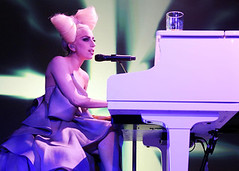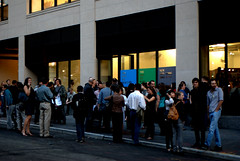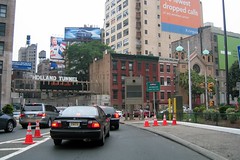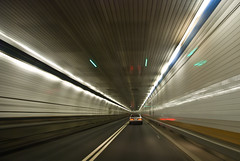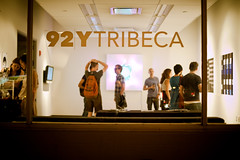West:
99 (corner): Socrates Restaurant Coffee Shoppe
Corner (6 Harrison): A beautiful brick-and-granite
landmark with a picturesque tower, an 1884 design by
Thomas R. Jackson. The Mercantile Exchange was
Organized in 1872 by dairy merchants as the Butter and Cheese Exchange,
NYMEX is now the largest physical commodities exchange
in the world.
The building, long since vacated by the Exchange, houses
Chanterelle, super-fancy French; if you
average the Zagat scores for food,
service and decor, it would come out as the
top restaurant in the city. Opened in SoHo in
1979; moved here in 1989.
Also here is Local 1180
of the Communications Workers of America, which represents city workers in
the public hospitals, Board of Ed, Transit Authority and Housing Authority,
among others.
|
|
81 (corner): Puffy's Tavern
77: Zutto, Japanese. Almost half as
expensive as Nobu--more than half as good.
73: XiaoPing Design, showroom for
Chinese manufacturers
67 (corner): Built as New York Hospital's
House of Relief (its downtown emergency room) in 1893,
this was later the U.S. Marine Hospital No. 70. Since
1985, it's been residential, but the medical tradition
continues with Tribeca Dental Health on the ground floor.
|
|
55 (corner): Washington Market School is in the
a striking 1890 red-brick McKim, Mead and White building (though I've
also seen this building attributed to Edward Hale Kendall). Actor Harvey Keitel
has lived here.
51 (corner): An 1881 red-brick building by
Stephen D. Hatch holds Babylicious, formerly Happy Baby Toys;
Wm. B. May Co. Real Estate,
established 1866; and H&H Building Consultants.
|
|
This small piece of land was bought by the city from Trinity
Church in 1797 for five dollars--the first land acquired by the
city for parkland. In 1636, it formed part of the
Annetje Jans farm, also known as Dominie's Bouwery,
or "minister's farm," after Jans' second husband, Everardus Bogardus,
who was the pastor of the Dutch Church. With the English takeover of New Amsterdam,
the land ended up in Trinity Church's extensive landholdings.
From 1871 until 1940, the park was landscaped to a design by
Central Park's Calvert Vaux and park superintendant Samuel Parsons.
A 1999 restoration attempted to bring back the spirit of the Parsons/Vaux
design.
|
|
|
East:
100 (block): Johns & Hicks
20th Century Furniture is in the Franklin-Hudson Building.
|
|
90 (corner): Downtown Wine & Liquors; Tribeca Luggage & Leather;
Douglas Elliman Real Estate, a large firm affiliated with Prudential
Life.
|
|
60 (block): A 1930 Art Deco landmark from Ralph Walker,
who also designed what is now the AT&T HQ. Still houses
many communications firms.
|
|
50 (corner): Was Lucius Pitkin, real
estate firm founded 1885.
42: Shoofly,
children's shoes and accessories
40: Tribeca Wine Merchants
36 (corner): Mohawk Atelier
is a high-end residential conversion of the
old Mohawk Electrical building, an 1892
Romanesque Revival building, in combination
with an 1845 whalebone factory on Duane.
|
|
